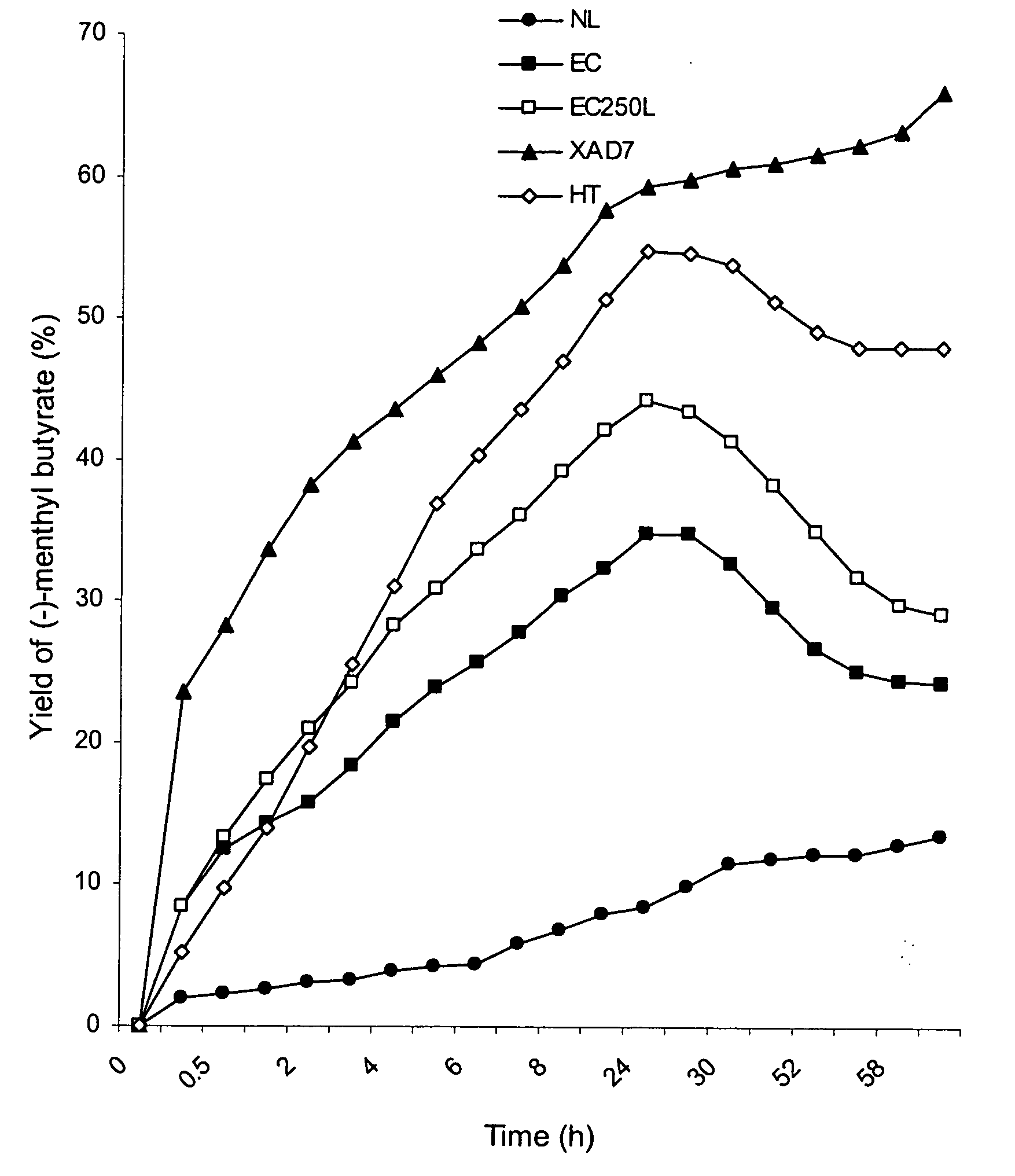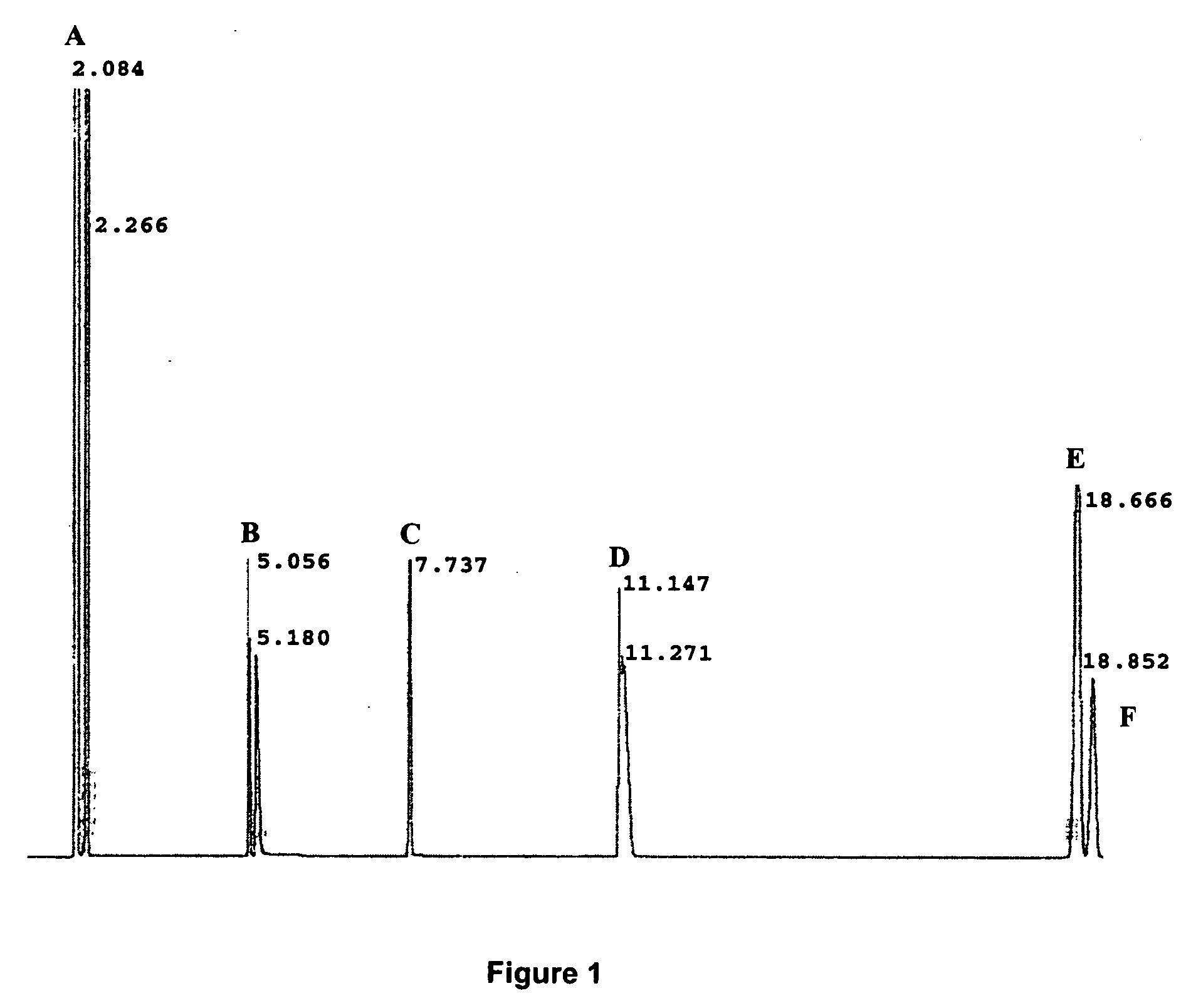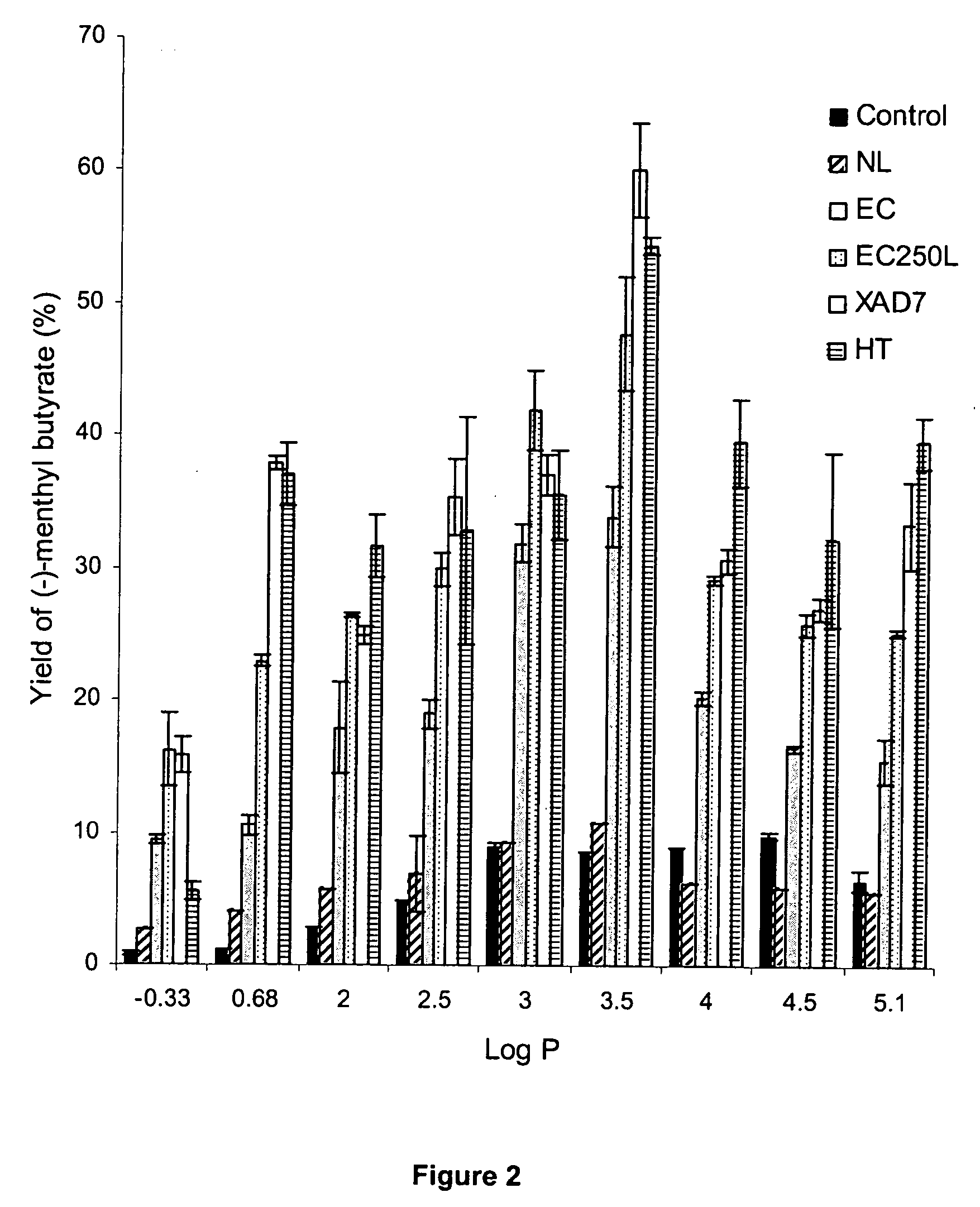Enantioselective immobilized lipase
a technology of immobilized lipase and immobilized lipase, which is applied in the field of immobilized lipase, can solve the problems of not being generally met with great success
- Summary
- Abstract
- Description
- Claims
- Application Information
AI Technical Summary
Problems solved by technology
Method used
Image
Examples
example 1
[0028] Effect of organic solvents with different hydrophobicity on Candida rugosa lipase activity was determined by using the general procedure but substituting hexane with various organic solvents such as acetonitrile, ethyl acetate, chloroform, toluene, carbon tetrachloride, n-heptane, iso-octane and n-nonane. The percentage yield of (−)-menthyl butyrate and enantioselectivity of each lipase used are shown in Table 5 and Table 6.
TABLE 5Activity of Candida rugosa Lipase as affected by various organicsolvents on production of (−)-menthyl butyrateYield of (−)-Menthyl Butyrate (%)SolventaLog PControlNLECEC250LXAD7HTAcetonitrile−0.330.8 ± 0.14.0 ± 0.6 9.4 ± 0.416.2 ± 2.815.8 ± 1.3 5.5 ± 0.7Ethyl acetate0.681.2 ± 0.05.8 ± 0.310.6 ± 0.822.9 ± 0.537.9 ± 0.537.0 ± 2.3chloroform2.002.9 ± 0.05.7 ± 0.017.9 ± 3.526.5 ± 0.224.9 ± 0.731.6 ± 2.4Toluene2.504.9 ± 0.09.3 ± 2.918.9 ± 1.129.9 ± 1.235.3 ± 2.832.8 ± 8.6CCl43.008.9 ± 0.35.8 ± 0.231.9 ± 1.441.9 ± 3.037.0 ± 1.535.5 ± 3.4Hexane3.508.5 ± 0...
example 2
[0031] Effect of temperature on Candida rugosa lipase activity was determined following the general procedure except that the reaction mixture was incubated at 40° C., 50° C., 60° C. and 70° C. aside from 30° C. The percentage yield of (−)-menthyl butyrate and enantioselectivity of each lipase used are shown in Table 7 and Table 8.
TABLE 7Activity of Candida rugosa Lipase as affected by varioustemperatures on production of (−)-menthyl butyrateTemperatureYield of (−)-Menthyl Butyrate (%)(° C.)ControlNLECEC250LXAD7HT30 8.5 ± 0.06.9 ± 0.633.9 ± 2.347.7 ± 4.260.1 ± 3.654.3 ± 0.64010.2 ± 0.06.7 ± 0.032.3 ± 0.346.9 ± 0.258.9 ± 1.650.2 ± 2.55011.3 ± 0.65.6 ± 0.020.0 ± 1.144.8 ± 0.531.9 ± 0.850.2 ± 2.560 6.4 ± 0.05.5 ± 0.822.6 ± 1.231.5 ± 2.525.6 ± 1.737.2 ± 2.87010.0 ± 1.5 5.2 ± 0.51 8.5 ± 2.724.8 ± 1.722.3 ± 0.037.2 ± 0.0
Reactions were performed in hexane for 24 hours.
Control = without enzyme,
NL = native lipase,
EC = Eupergit ® C-lipase,
EC250L = Eupergit ® C 250 L-lipase,
XAD7 = Amber...
example 3
[0033] Effect of water activity (as) on Candida rugosa lipase activity was determined following the general procedure except that the reaction mixture and lipase were pre-equilibrated with saturated salt solutions vapor of known water activity overnight prior incubation. Salt hydrates used were LiCl, MgCl2.6H2O, Mg(NO3)2.6H2O, NaCl, KCl and KNO3. The percentage yield of (−)-menthyl butyrate and enantioselectivity of each lipase used are shown in Table 9 and Table 10.
TABLE 9Activity of Candida rugosa Lipase as affected by various wateractivities (aw) on production of (−)-menthyl butyrateYield of (−)-Menthyl Butyrate (%)Salt HydrateawcontrolNLECEC250LXAD7HTLiCl0.117.8 ± 0.615.3 ± 0.617.6 ± 0.640.7 ± 1.923.2 ± 0.842.6 ± 3.2Mgcl2.6H2O0.338.4 ± 0 8.2 ± 0 36.2 ± 2.945.3 ± 2.143.4 ± 5.742.1 ± 1.0Mg(NO3)2.6H2O0.537.9 ± 0.211.5 ± 0.232.6 ± 0.141.0 ± 1.958.7 ± 2.338.4 ± 1.8NaCl0.759.1 ± 0.110.4 ± 0.126.7 ± 0.338.2 ± 3.025.4 ± 0 39.0 ± 0.0KCl0.867.4 ± 2.613.8 ± 2.618.1 ± 1.738.2 ± 1.027.2 ...
PUM
 Login to View More
Login to View More Abstract
Description
Claims
Application Information
 Login to View More
Login to View More - R&D
- Intellectual Property
- Life Sciences
- Materials
- Tech Scout
- Unparalleled Data Quality
- Higher Quality Content
- 60% Fewer Hallucinations
Browse by: Latest US Patents, China's latest patents, Technical Efficacy Thesaurus, Application Domain, Technology Topic, Popular Technical Reports.
© 2025 PatSnap. All rights reserved.Legal|Privacy policy|Modern Slavery Act Transparency Statement|Sitemap|About US| Contact US: help@patsnap.com



